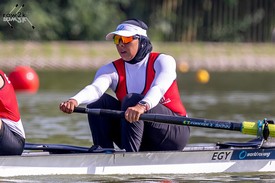The Stroke-Coxswain relationship is one of the most important working relationships in all of athletics. Their communication is vital; when the Stroke and Coxswain are on the same wavelength, when their thinking meshes on a level more subtle than words, it is a good feeling for the entire boat. This column is meant as an affectionate tribute to the many exceptional Strokes I have had the good fortune to work with and learn from.
Your Stroke is your mirror to the psychology of the entire boat. Consult all your rowers on everything, and share in turn your own reasoning, thinking and strategy, but heed your Stroke's advice particularly. A lot of non-verbal communication goes on as well. The intonation of a monosyllable, the lift of an eyebrow during a piece, properly read can tell volumes about how the piece is going, where the rating ought to be, whether there is true swing in the boat, etc. Watch your Stroke's face more than your coxbox. You'll find more of the information you really need there. There are Strokes and Coxswains who carry on entire conversations in monosyllables and small gestures. (They "know each other's 'handwriting'".) Similarly, your enthusiasm and intensity communicate themselves to the boat via the Stroke. If your Stroke responds to the things you say, chances are good the rest of the boat will too.
Am I saying that every suggestion the Stroke makes is solid gold, and that the coxswain should follow the Stroke's word in everything? Damn near. Don't be worried about your Stroke "trying to cox the boat." It almost never happens. The Stroke has more than enough on his or her mind; the last thing he or she wants is to add to it. Once during a head race, I let the rating creep two beats higher than my Stroke and I had previously planned, but the information on which I based that decision came -- indirectly -- from the Stroke himself. I could tell by the look on his face and by the set of his shoulders that the boat was moving well at the higher rating. Even though not a word was said, it was still very much a mutual decision.
The coach will have his or her own ideas on what makes a good Stroke: someone who has a smooth, naturally followable rhythm, whose catches are firm, constant and easy for the other rowers to read, someone who can take the rating up or down smoothly, and someone with fierce competitive instincts who can get the boat fired up on race days.
You, as coxswain, have a slightly different agenda. You want someone who:
- is tall enough to obscure the other rowers' view of the curves in your wake,
- wears mirrored sunglasses so that you can monitor the other boats in the race (of course they will be behind you) without your having to turn around to look.
- has sufficiently adept fine motor coordination to pin your race number on your back with a minimum of bloodshed.
You also want a Stroke who can tell the difference between windward and leeward so that he/she can clear the gunwale (and your knees) comfortably when he/she spits during a piece, and -- this is very important -- after a hard race or practice will avoid throwing up all over the coxswain's feet.
Try not to refer to Strokes as "Assistant Coxswains" where they can hear you. They don't like that.
If you enjoy and rely on row2k, we need your help to be able to keep doing all this. Though row2k sometimes looks like a big, outside-funded operation, it mainly runs on enthusiasm and grit. Help us keep it coming, thank you! Learn more.
- Bont Rowing
- Calm Waters Rowing
- Concept 2
- Craftsbury Sculling
- The Crew Classic
- CrewLAB
- Croker
- Durham Boat Co.
- Empacher
- Faster Masters
- Filippi
- Fluidesign
- h2row.net
- HUDSON
- Live2Row Studios
- Nielsen-Kellerman
- Oak Ridge RA
- Peinert Boat Works
- Pocock Racing Shells
- Race1 USA
- RowKraft
- Rubini Jewelers
- Vespoli USA
- WinTech Racing
- Bont Rowing
- Calm Waters Rowing
- Concept 2
- Craftsbury Sculling
- The Crew Classic
- CrewLAB
- Croker
- Durham Boat Co.
- Empacher
- Faster Masters
- Filippi
- Fluidesign
- h2row.net
- HUDSON
- Live2Row Studios
- Nielsen-Kellerman
- Oak Ridge RA
- Peinert Boat Works
- Pocock Racing Shells
- Race1 USA
- RowKraft
- Rubini Jewelers
- Vespoli USA
- WinTech Racing

















